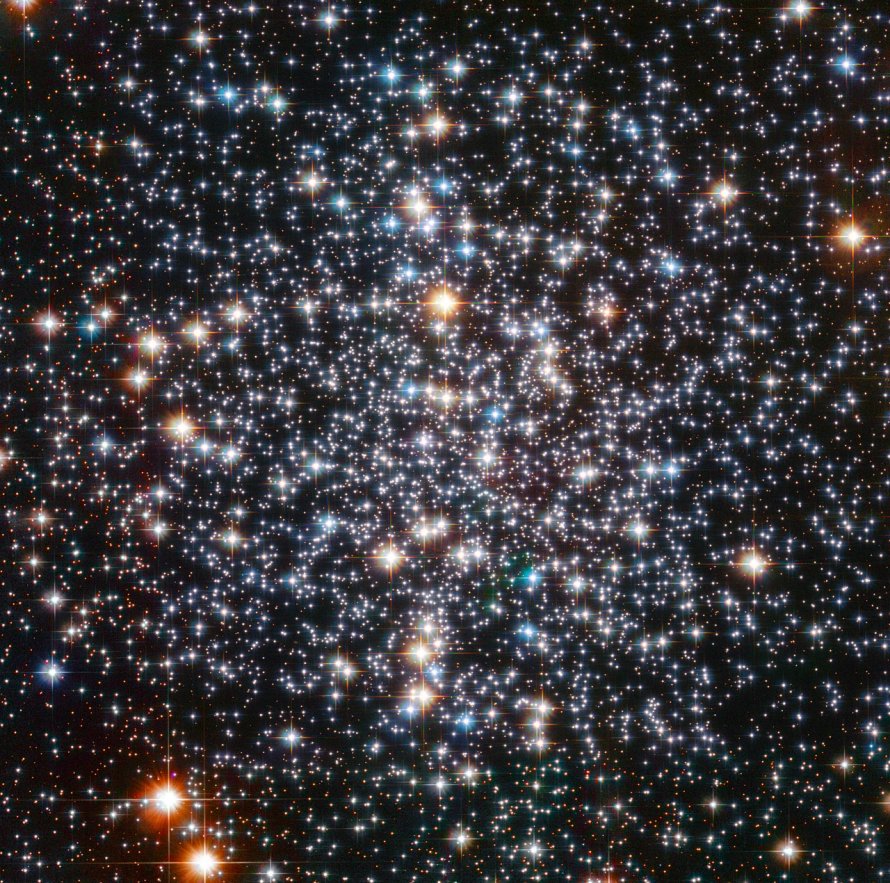M4 (NGC 6121)
Messier 4 (NGC 6121) is a globular cluster located in the constellation Scorpius, in the Galactic Center of the Milky Way Galaxy in the Local Group of galaxies. M4 is 7200 light years away from Earth.
M4 is best viewed during mid-summer, is magnitude 5.9, and can be viewed with naked eye (barely). M4 is 26' in apparent size. For reference, the full moon is 30'.
Observing difficulty: Intermediate
- Name:
- Type:
- globular cluster
- Constellation:
- Scorpius
- NGC or IC:
- NGC 6121
- Magnitude:
- 5.9
- Viewing:
- naked eye (barely)
- Size:
- 26'
- Distance (light years):
- 7200 LY
- RA:
- 16h 23.6m
- Dec:
- -26 32'
- Season:
- mid-summer
- Milky Way location:
- Galactic Center
- Galaxy group:
- Local Group
- Messier Marathon #:
- 82
- Contains:
- CX-1 binary pulsar
* The naked eye can see up to magnitude ~7-8 objects under ideal dark sky conditions.
A Globular Gem in the Constellation of Scorpius
One of the sky's most remarkable globular clusters, Messier 4, aka M4 or NGC 6121, resides in the constellation of Scorpius. As one of the closest globular clusters to Earth, M4 presents a particularly fascinating study of stellar dynamics, evolution, and population. This article provides an in-depth technical exploration of M4, encompassing its discovery, physical properties, stellar composition, and scientific significance.
Discovery and Observation
Messier 4 was discovered by Swiss astronomer Philippe Loys de Ch?seaux in 1745-46 but was later independently found and cataloged by Charles Messier in 1764. Located about 7,200 light-years away from Earth, M4 is one of the nearest globular clusters, making it an observable object with any binoculars or a small telescope.Its proximity to Antares, one of the brightest stars in the sky, makes it easy to locate.
Physical Characteristics
M4 spans about 75 light-years in diameter, with its core spanning approximately 10 light-years. This globular cluster is particularly noted for its "central bar" structure, a feature distinguished by a horizontal stripe of stars across its core. M4's tidal radius, the outermost boundary from the center where gravitational influence retains its stars, is estimated to be around 34 light-years. Interestingly, M4 rotates at a speed of 11.4 km/s, with the rotation axis being roughly aligned with the line of sight from Earth.
Stellar Composition
With an estimated age of 12.2 billion years, M4 is home to some of the universe's oldest stars. The cluster contains several tens of thousands of stars, which, due to their age, are generally metal-poor, indicating a lack of elements heavier than helium. The predominant types are red giants, and there is a significant population of blue stragglers, anomalous stars that appear younger than their surrounding counterparts. M4 also contains a noticeable number of white dwarfs, the remnants of low-mass stars.
Unique Features and Phenomena
One of M4's most notable features is the presence of a millisecond pulsar, designated PSR B1620-26. This pulsar, a rapidly rotating neutron star, is in a binary system with a white dwarf and a planet. This arrangement, often referred to as a "pulsar planet," is one of the oldest known planetary systems in the universe. The presence of this system in M4 offers a unique opportunity to study the complex interactions and evolution of stars and planets in a dense stellar environment.
Scientific Significance
Given its relative proximity to Earth and diverse stellar population, M4 holds immense scientific significance. Studying the characteristics of this cluster and its individual stars can provide invaluable insights into the processes of stellar evolution and the conditions that prevailed in the early universe. The cluster's large number of variable stars and the unique planetary system of PSR B1620-26 serve as important benchmarks for theoretical modeling and the calibration of distance scales in astronomy.
Apparent Magnitude and Distance
The globular cluster M4 has an apparent magnitude of 5.9, making it faintly visible to the naked eye under good conditions. It is located approximately 7,200 light-years away from us, making it one of the closest globular clusters to the Solar System.
Finding and Observing Messier 4
M4 is located very near to Antares, the brightest star in Scorpius, and one of the brightest stars in the night sky. This makes M4 relatively easy to find in the night sky, especially from the Southern Hemisphere during the winter months, and from mid-spring to early summer for observers in the Northern Hemisphere.
Given its magnitude, M4 can be glimpsed with the naked eye in very dark skies. However, binoculars or a small telescope will offer a better view. With a medium-sized telescope, amateur astronomers will be able to observe the central bar and some of the brighter stars that constitute the cluster.



